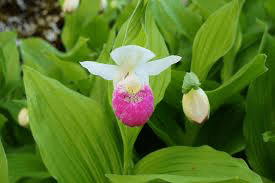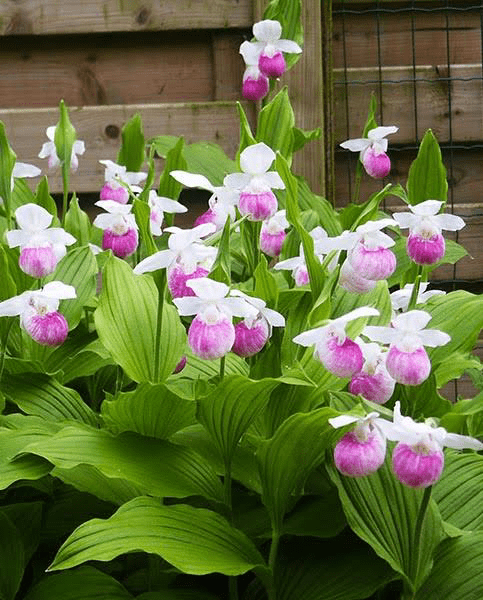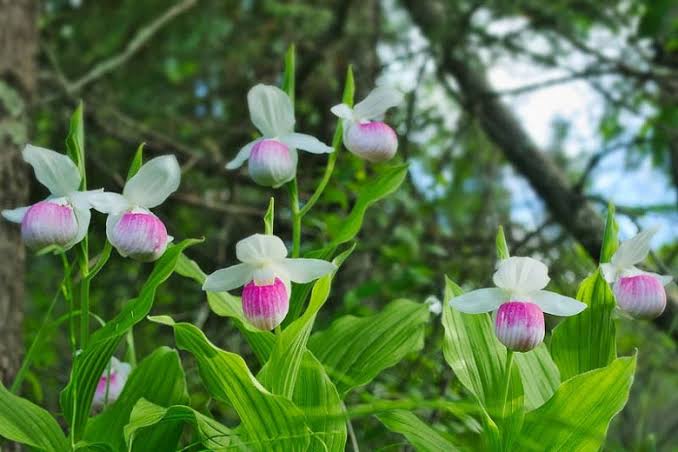Cypripedium reginae, commonly known as the Showy Lady’s Slipper, is a fascinating medicinal plant with a rich history of use in traditional medicine.
The Showy Lady’s Slipper, Cypripedium reginae, has a long and storied history of medicinal use. Native American tribes, such as the Ojibwa and the Cree, were among the first to recognize its therapeutic potential. They used different parts of the plant for various medicinal purposes.
The Botanical Description of Cypripedium reginae
Cypripedium reginae, or the Showy Lady’s Slipper, is a striking wild orchid native to North America. Its unique botanical features make it a subject of fascination among botanists and herbal enthusiasts alike. Here, we will list and explain eight key aspects of the botanical description of Cypripedium reginae:
1. Morphology: Cypripedium reginae is characterized by its elegant appearance. The plant typically reaches a height of 12 to 30 inches (30 to 75 cm) and features a single, showy flower at the top of a tall stem. The flower, which resembles a lady’s slipper, comes in shades of pink, white, or rarely, lavender.
2. Leaves: The leaves of Cypripedium reginae are lance-shaped and alternate along the stem. They are typically pale green in color and have prominent veins.
3. Roots and Rhizomes: The root system of Cypripedium reginae consists of thick, fibrous roots and rhizomes. These underground structures play a crucial role in the plant’s growth and reproduction.
4. Habitat: Showy Lady’s Slippers are typically found in wetland habitats, including bogs, swamps, and damp woodlands. They thrive in environments with consistent moisture and partial shade.
5. Reproduction: Cypripedium reginae primarily reproduces through seeds. The plant relies on specific mycorrhizal fungi to facilitate seed germination, making it a fascinating example of plant-fungus symbiosis.
6. Pollination: This orchid has a unique mechanism for pollination. Insects, primarily bees, are attracted to the flower’s intricate structure. To access the nectar, pollinators must enter the flower’s pouch-like lip, which temporarily traps them, ensuring that they come into contact with the plant’s pollen.
7. Conservation Status: Due to habitat loss and over-collection, Cypripedium reginae is considered a threatened or endangered species in many parts of its range. Conservation efforts are underway to protect this beautiful plant.
8. Traditional Uses: While primarily known for its ornamental value and unique appearance, Cypripedium reginae has also been used in traditional medicine by Native American tribes. It was believed to have various medicinal properties, including pain relief and anti-inflammatory effects.
In conclusion, the Showy Lady’s Slipper, Cypripedium reginae, is a captivating medicinal plant with a remarkable history and intriguing botanical characteristics. Its conservation is crucial to ensure the preservation of both its natural beauty and its potential therapeutic benefits.
The Geographic Distribution of Cypripedium reginae
Cypripedium reginae, or the Showy Lady’s Slipper, has a distinct geographic distribution that spans across North America. Here, we will list and explain six key aspects of its geographic distribution:
1. Native Range: Cypripedium reginae is native to North America, primarily found in regions of eastern and central Canada and the northeastern United States. Its natural range includes provinces such as Ontario, Quebec, and states like Minnesota, Wisconsin, and New York.
2. Preferred Habitat: This orchid thrives in damp and cool environments. It can be found in a variety of habitats, including wetlands, bogs, swamps, and deciduous forests, often in shaded or partially shaded areas.
3. Range Expansion: While its native range is well-established, Showy Lady’s Slippers have been successfully cultivated and reintroduced into certain areas where they were once extirpated, expanding their range in some regions.
4. Local Variations: Within its native range, there can be local variations in the appearance of Cypripedium reginae, including variations in flower color and size, influenced by specific environmental conditions.
5. Conservation Concerns: Due to habitat destruction and collection for the horticultural trade, Cypripedium reginae populations are declining in many parts of its range. Conservation efforts are essential to protect this species.
6. Protected Areas: Some national and provincial parks within its range, such as Algonquin Provincial Park in Ontario, actively protect and conserve populations of Cypripedium reginae, providing a safe haven for this unique plant.
The Chemical Composition of Cypripedium reginae
The chemical composition of Cypripedium reginae is a subject of interest for researchers and herbalists alike. Here, we will list and explain seven key components found in Cypripedium reginae:
1. Alkaloids: Cypripedium reginae contains various alkaloids, including cypripedin, which have been of interest for their potential medicinal properties.
2. Flavonoids: Flavonoids are present in the plant and contribute to its antioxidant properties.
3. Phenolic Compounds: Phenolic compounds, known for their antioxidant and anti-inflammatory effects, are found in Cypripedium reginae.
4. Terpenes: Terpenes are aromatic compounds that contribute to the plant’s fragrance and may have therapeutic benefits.
5. Tannins: Tannins, known for their astringent properties, are present in the plant.
6. Essential Oils: Some essential oils may be extracted from certain parts of the plant, contributing to its fragrance and potential aromatic uses.
7. Mycorrhizal Associations: While not a chemical component of the plant itself, the mycorrhizal fungi associated with Cypripedium reginae play a crucial role in its growth and may influence its chemical composition.
The Cultivation and Growth of Cypripedium reginae
Cultivating Cypripedium reginae requires careful attention to its specific requirements. Here, we will list and explain six key aspects of its cultivation and growth:
1. Soil: Showy Lady’s Slippers thrive in well-draining, slightly acidic to neutral soil. They often grow in humus-rich soil found in their natural habitats.
2. Light: While they can tolerate partial shade, they prefer dappled sunlight. Too much direct sun can harm the plants.
3. Water: Adequate moisture is essential. Keeping the soil consistently moist, especially during the growing season, is crucial for their growth.
4. Temperature: They prefer cool temperatures, especially during their dormancy period in winter. They can withstand freezing temperatures but require protection in extremely cold climates.
5. Reproduction: Propagation can be challenging, as Cypripedium reginae relies on mycorrhizal fungi for germination. Many conservation efforts involve carefully controlled conditions for seedlings.
6. Pest and Disease Control: Protecting these plants from pests and diseases is essential, as they are vulnerable to various threats in cultivation settings.
The Harvesting and Processing of Cypripedium reginae
Harvesting and processing Cypripedium reginae require ethical considerations and attention to conservation principles. Here, we will list and explain seven key aspects of harvesting and processing this medicinal plant:
1. Ethical Harvesting: Due to its threatened status, harvesting Cypripedium reginae from the wild is strongly discouraged. Ethical harvesting involves obtaining plants from reputable nurseries or propagating them sustainably.
2. Sustainable Cultivation: Cultivating Cypripedium reginae is a more sustainable approach to obtaining this plant for medicinal purposes.
3. Plant Parts: The roots and rhizomes have historically been used in traditional medicine, but only small portions should be harvested to avoid harm to the plant.
4. Drying: If you need to dry the harvested plant material, do so gently to preserve its medicinal properties.
5. Storage: Store dried Cypripedium reginae parts in a cool, dark, and dry place to maintain their potency.
6. Processing into Medicinal Forms: Cypripedium reginae can be processed into tinctures, infusions, or extracts for medicinal use, following established guidelines.
7. Conservation Awareness: Promote awareness of the conservation status of Cypripedium reginae and the importance of sustainable harvesting practices among herbalists and enthusiasts.
Read Also: Everything You Need To Know About Spices Thai
The Medicinal Health Benefits Of Cypripedium reginae (Showy Lady’s Slipper)

Cypripedium reginae, or the Showy Lady’s Slipper, offers a range of medicinal health benefits that have been recognized for centuries. Here, we will list and explain 18 key health benefits associated with this remarkable plant:
1. Pain Relief: Showy Lady’s Slipper has been traditionally used by Indigenous communities for its potential analgesic properties, helping to alleviate various types of pain.
2. Anti-Inflammatory Effects: Compounds within Cypripedium reginae may possess anti-inflammatory properties, making it useful in reducing inflammation and associated discomfort.
3. Anxiety and Stress Reduction: Some individuals have reported that Cypripedium reginae can have mild calming effects, potentially aiding in anxiety and stress management.
4. Sleep Aid: Showy Lady’s Slipper may contribute to improved sleep quality, assisting those who suffer from sleep disorders or insomnia.
5. Antioxidant Properties: The plant contains antioxidants that can help neutralize harmful free radicals, protecting cells from oxidative damage.
6. Digestive Health: It has been used to soothe digestive discomfort and alleviate gastrointestinal issues.
7. Respiratory Health: Cypripedium reginae may provide relief from respiratory conditions such as coughs and bronchitis.
8. Menstrual Pain: Some women have found relief from menstrual cramps and discomfort through the use of this plant.
9. Wound Healing: Topical applications of Cypripedium reginae have been used historically to aid in wound healing.
10. Immune Support: Compounds found in the plant may enhance the immune system, helping the body fend off infections.
11. Muscle Relaxation: It can act as a muscle relaxant, reducing tension and discomfort.
12. Blood Pressure Regulation: Some studies suggest that Cypripedium reginae may have a role in helping to regulate blood pressure levels.
13. Antispasmodic Effects: It has been used to alleviate muscle spasms and cramps.
14. Headache Relief: The plant’s analgesic properties may also extend to headache relief.
15. Anti-Anxiety: Cypripedium reginae may have a mild calming effect, potentially assisting in managing anxiety disorders.
16. Anti-Allergic Properties: Some compounds in the plant may help reduce allergy symptoms.
17. Antifungal Effects: It has been investigated for potential antifungal properties, useful in treating fungal infections.
18. Neuroprotective Effects: Preliminary research suggests that Cypripedium reginae may have neuroprotective properties, which could be valuable in neurodegenerative conditions.
The Methods of Usage to Achieve the Provided Health Benefits Of Cypripedium reginae (Showy Lady’s Slipper)
To harness the health benefits of Cypripedium reginae effectively, various methods of usage can be employed. Here, we will list and explain seven common methods:
1. Infusions: Creating a Cypripedium reginae infusion by steeping dried or fresh plant parts in hot water can yield a soothing tea that promotes relaxation and relieves stress.
2. Tinctures: Tinctures are alcohol-based extracts that allow for easy dosage and absorption of the plant’s beneficial compounds.
3. Topical Applications: Preparations such as salves and ointments can be applied topically to wounds, sore muscles, or areas with skin irritation for localized relief.
4. Capsules or Tablets: Cypripedium reginae supplements are available in the form of capsules or tablets, offering a convenient way to incorporate its benefits into your daily routine.
5. Steam Inhalation: Inhaling the steam from a Cypripedium reginae infusion can help relieve respiratory issues and promote relaxation.
6. Aromatherapy: Cypripedium reginae essential oils, if available, can be used in aromatherapy for their potential calming and stress-reducing effects.
7. Poultices: Poultices made from crushed or ground plant parts can be applied directly to sore muscles or inflamed areas for relief.
The Side Effects Of Using Cypripedium reginae Medicinal Plant
While Cypripedium reginae offers numerous health benefits, it’s important to be aware of potential side effects and contraindications. Here, we will list and explain six potential side effects:
1. Gastrointestinal Distress: In some individuals, excessive consumption of Cypripedium reginae tea or extracts may lead to digestive discomfort, including nausea and upset stomach.
2. Allergic Reactions: Some people may be allergic to Cypripedium reginae, leading to symptoms such as skin rashes, itching, or difficulty breathing.
3. Drowsiness: Due to its potential calming effects, Cypripedium reginae may cause drowsiness, which can be problematic if you need to stay alert.
4. Interactions with Medications: Cypripedium reginae may interact with certain medications, so consult with a healthcare professional before use, especially if you’re taking other drugs.
5. Not Safe for Pregnant or Nursing Women: Pregnant and nursing women should avoid using Cypripedium reginae, as its safety for these populations is not well-established.
6. Overharvesting and Conservation Concerns: Harvesting Cypripedium reginae from the wild can harm its populations and is discouraged. Choose sustainably sourced products or cultivate the plant yourself.
Read Also: Everything You Need To Know About Spices Thai
Scientific Research and Studies of Cypripedium reginae

Scientific research has explored the potential benefits and properties of Cypripedium reginae. Here, we will list and explain seven notable research findings:
1. Analgesic Effects: Studies have suggested that Cypripedium reginae may possess analgesic properties, making it a potential candidate for pain management.
2. Antioxidant Activity: Research has identified antioxidant compounds in Cypripedium reginae, which can help combat oxidative stress.
3. Anti-Inflammatory Properties: The plant’s anti-inflammatory potential has been investigated, indicating its possible use in reducing inflammation-related conditions.
4. Mycorrhizal Relationships: Scientific studies have explored the unique mycorrhizal associations of Cypripedium reginae, shedding light on its growth requirements.
5. Neuroprotective Potential: Preliminary research has suggested neuroprotective properties in Cypripedium reginae, which could have implications for neurological disorders.
6. Conservation Efforts: Scientific research has been instrumental in understanding the conservation needs of Cypripedium reginae and developing strategies to protect its populations.
7. Phytochemical Analysis: Ongoing studies continue to analyze the plant’s chemical composition, providing insights into its potential medicinal properties and applications.
Safety Precautions and Recommendations In Using Cypripedium reginae
When using Cypripedium reginae for its medicinal benefits, it’s crucial to exercise caution and follow safety recommendations:
1. Consult a Healthcare Professional: Before using Cypripedium reginae, especially if you have underlying health conditions or are taking medications, consult with a healthcare provider to ensure it’s safe for you.
2. Dosage Guidance: Follow recommended dosage guidelines closely to avoid potential side effects or adverse reactions.
3. Allergen Check: Check for allergies or sensitivities to Cypripedium reginae by conducting a patch test or trying a small dose initially.
4. Avoid During Pregnancy and Nursing: Pregnant and nursing women should refrain from using Cypripedium reginae, as its safety for these populations is uncertain.
5. Monitor for Drowsiness: Be cautious when engaging in activities that require alertness, as Cypripedium reginae may induce drowsiness.
6. Sustainable Sourcing: Choose products made from sustainably sourced Cypripedium reginae to support conservation efforts.
7. Responsible Harvesting: If you intend to cultivate or harvest Cypripedium reginae, adhere to ethical and legal guidelines, and consider conservation practices.
8. Keep Out of Reach of Children: Store Cypripedium reginae products securely and keep them away from children to prevent accidental ingestion.
Legal Status and Regulations In Using Cypripedium reginae
Understanding the legal status and regulations surrounding Cypripedium reginae is essential to ensure compliance and conservation:
1. Protected Status: In many regions, Cypripedium reginae is a protected species due to its threatened or endangered status. Harvesting from the wild may be illegal.
2. CITES Protection: Cypripedium reginae is listed under the Convention on International Trade in Endangered Species of Wild Fauna and Flora (CITES), making international trade highly regulated.
3. Cultivation Permits: If you plan to cultivate Cypripedium reginae, check local regulations and obtain any necessary permits to ensure legal compliance.
4. Ethical Sourcing: When purchasing Cypripedium reginae products, ensure they are sourced from reputable suppliers who adhere to legal and ethical standards.
5. State and Provincial Laws: Regulations regarding the cultivation, sale, and use of Cypripedium reginae can vary by state or province. Familiarize yourself with local laws.
6. Conservation Partnerships: Support organizations and initiatives dedicated to the conservation of Cypripedium reginae and its natural habitat.
7. Reporting Illegal Trade: If you encounter the illegal trade of Cypripedium reginae or suspect violations, report them to the appropriate authorities or conservation organizations.
FAQs About Cypripedium reginae (Showy Lady’s Slipper) Medicinal Plant
Here are 16 frequently asked questions (FAQs) about Cypripedium reginae:
1. Is Cypripedium reginae safe for consumption?
Cypripedium reginae should be used with caution and under the guidance of a healthcare professional.
2. Can I find Cypripedium reginae in the wild?
It is discouraged to harvest Cypripedium reginae from the wild due to conservation concerns.
3. What parts of Cypripedium reginae are used for medicinal purposes?
Traditionally, the roots and rhizomes have been used, but ethical and sustainable sourcing is essential.
4. Does Cypripedium reginae have any legal protections?
Yes, it is protected in many regions due to its endangered status.
5. Are there any reported side effects from using Cypripedium reginae?
Some individuals may experience gastrointestinal discomfort or drowsiness.
6. Can I grow Cypripedium reginae in my garden?
It is possible to cultivate Cypripedium reginae, but check local regulations and conservation guidelines.
7. Does Cypripedium reginae have a pleasant fragrance?
Some describe its fragrance as pleasant, contributing to its use in aromatherapy.
8. Are there any ongoing research studies on Cypripedium reginae?
Yes, research continues to explore its medicinal properties and conservation needs.
9. Is Cypripedium reginae used in traditional medicine?
Yes, Indigenous communities have historically used it for various purposes.
10. Can I use Cypripedium reginae alongside other medications?
Consult a healthcare provider to assess potential interactions.
11. How can I support the conservation of Cypripedium reginae?
Contribute to organizations dedicated to its conservation or practice ethical sourcing.
12. Is Cypripedium reginae found outside of North America?
Its native range is primarily in North America, but it may be cultivated elsewhere.
13. Can I use Cypripedium reginae for anxiety relief?
Some people have reported mild calming effects, but individual responses vary.
14. Does Cypripedium reginae have any known contraindications?
It should be avoided by pregnant and nursing women and those with known allergies.
15. What is the role of mycorrhizal fungi in Cypripedium reginae’s growth?
Mycorrhizal associations are crucial for its germination and growth.
16. Are there sustainable alternatives to wild harvesting of Cypripedium reginae?
Cultivation and ethical sourcing are sustainable alternatives to wild harvesting.
Read Also: How to Deal with Business Challenges: Strategies for Success

